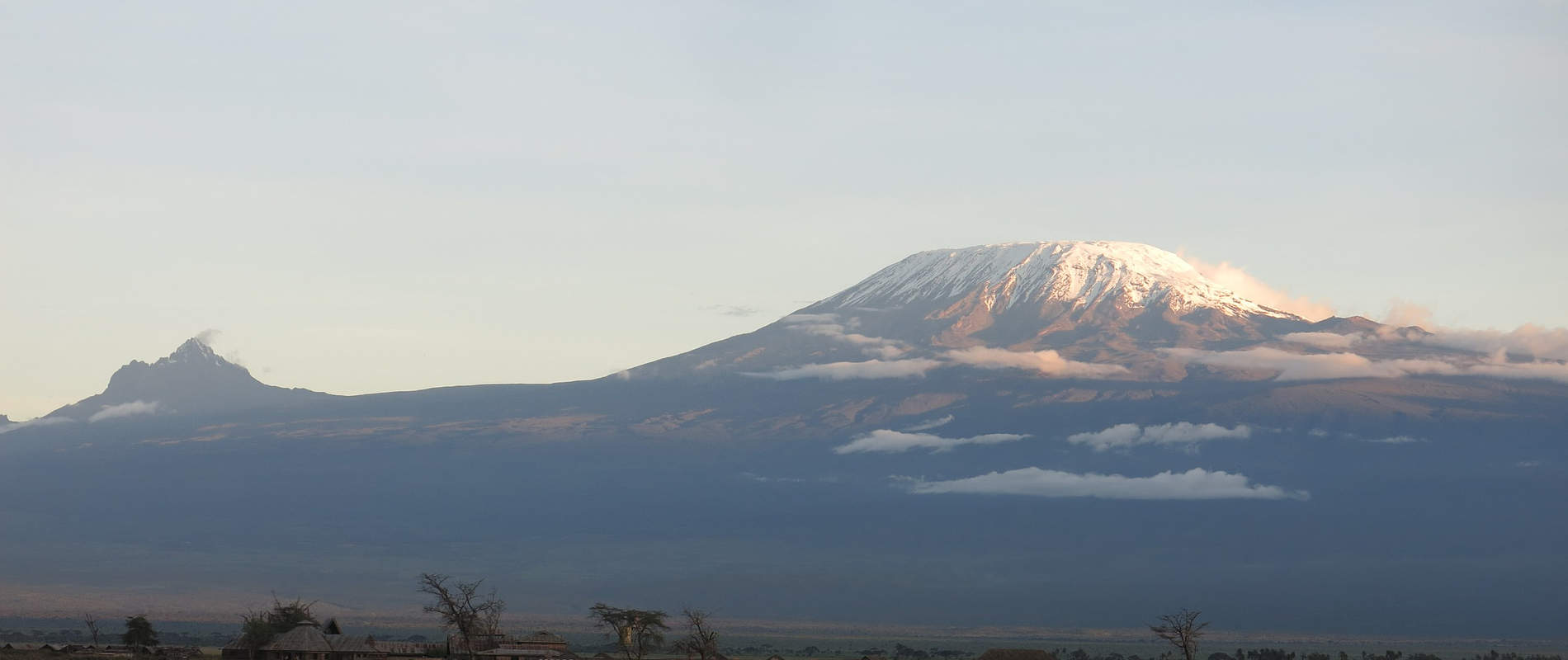FIELD VETERINARY REPORT FOR SOUTHERN CONSERVATION AREA MOBILE VETERINARY UNIT FOR THE MONTH OF JUNE: 2018 Reported by Ndambiri Ephantus Introduction The month under review was characterized by the end of the rainy season and the beginning of the cold and dry weather conditions
FIELD VETERINARY REPORT FOR SOUTHERN CONSERVATION AREA MOBILE VETERINARY UNIT FOR THE MONTH OF JUNE: 2018
Reported by Ndambiri Ephantus
Introduction
The month under review was characterized by the end of the rainy season and the beginning of the cold and dry weather conditions. Park environs remain fairly wet although the substantial pools of flood rain water seem to be drying up quickly. Wild animals have begun moving in from surrounding conservancies as water resources are drying up. It is becoming easier to navigate your way through the park as the roads are finally drying up after the heavy rains. There is still plenty of vegetation throughout the Park and many animals can still be seen grazing throughout the plains. Few clinical and human-wildlife conflict cases were witnessed during the month.
The following are veterinary activities attended to during the month:
CASE #1 ELEPHANT TREATMENT
Date: 03/06/2018
Species: Loxodonta africana
Sex: Male
Age: Adult
Location: Oldonyo Uwas Lodge; Chyulu Hills
History
The bull was spotted and reported by Big Life Foundation as having several wounds and was in need of immediate medical treatment. As it was spotted at Oldonyo Uwas Lodge’s water hole, the veterinary team knew they had to act quickly and intervene before the animal moved on into thicker bush where he would be hard to reach. The veterinary team launched the intervention with the help of the Lodge Security Team.
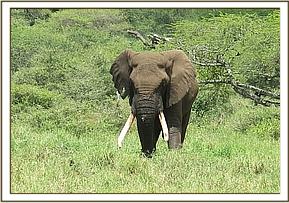

Immobilization, Examination and Treatment
The bull was found at the waterhole, in the company of another huge bull, splashing water on his body, probably to relieve the pain from his wounds as he seemed to really be focusing on them. After observation, it was found that the bull had at least four pus exuding wounds, and that an intervention was paramount. A 3cc dart constituting of 18mgs Etorphine was loaded into a Dan-Inject Gun. The team approached the bulls slowly via vehicle. The bulls had already begun to slowly move away from the watering hole. After a couple of minutes the team was able to successfully dart the bull on the mid left arm. The bull gave a few quick bouts trying to remove the dart, but he settled after a couple of minutes behind a thicket and started spraying soil on his wounds and the rest of his body. The other bull oblivious to what was happening strolled away quietly. The bull remained still for several minutes before exhibiting standing anesthesia. He was down on both carpi supporting his head with his strong tusks. The team of ten pulled the bull onto his left lateral recumbence by wrapping a rope around his pelvis. He was blindfolded using his right ear and his trunk was kept open with a piece of stick placed across the distal nares. Water was doused on his ears to help cool him down.
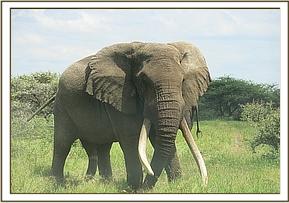
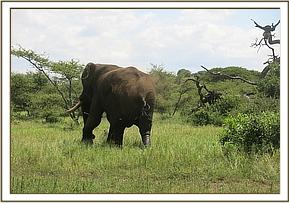
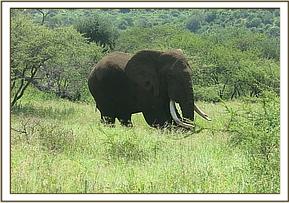

The bull was suffering from five spear wounds. One, rostrally at mid trunk area about fifteen centimeters deep dorsally. The second wound was at the right armpit area, about thirty centimeters deep rostrally. The third wound was on his mid right gluteal muscles, was maggot infested and was about twenty centimeters deep ventrally. The fourth wound was at the ventral inguinal area at the base of the penis and was about fifteen centimeters deep. First and fourth wounds were fresher than the other two. This meant that they were inflicted at different times but all were more than two weeks old. The last one was the torn right ear which was a hole of about twenty diameters.The pus discharging wounds were cleaned using swabs mounted on arm long forceps which were inserted into the wounds to scoop out the pus as much as possible. This was done several times before the wounds were thoroughly disinfected using Hydrogen Peroxide and Iodine. The two posterior wounds were injected with 40mgs Ivermectin each because of the maggot infestations. All the wounds were then generously covered with green clay to obscure them from ox peckers and to encourage tissue regeneration. Another shallow wound with creamy pus was discovered near the right ilium. It was cleaned as and covered with clay like the other wounds. All the wounds were finally generously sprayed with Tetracycline wound spray to deter flies. Systemically the bull was injected in different muscle sites with 40000mgs Amoxicillin and 2500mgs Flunixin Meglumine.
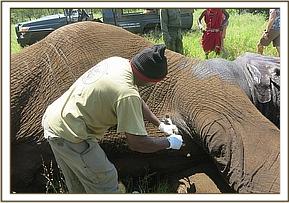

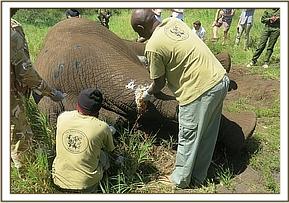

Reversal and Prognosis
Reversal was done after twenty eight minutes post darting with 40mgs Naltrexone mixed with 24mgs Diprenorphine in one single syringe and administered into ear vein. The bull was up after two minutes. He was calm and just begun dusting the wounds with loose earth. His prognosis is favorable.
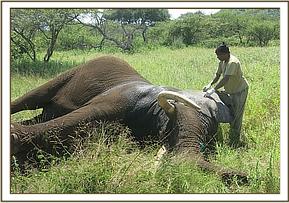

CASE #2 COLLARING OF A PROBLEMATIC LIONESS
Date: 05/06/2018
Species: Panthera leo
Sex: Female
Age: Adult
Location: Kwesu area; Imbirikani Amboseli Ecosystem
History
Lion Guardian had been given the go ahead to collar problematic lions in the area. The project employs scouts who monitor the lions and inform the community of lion presence in an area to avert possible human-wildlife conflict. They also help to chase the lions away from bomas. Through their monitoring systems they are able to identify the problematic lions that are continuously killing livestock. These lions are specific individuals that have been categorized over years of observational data to be chronic problem lions.The lioness in question was eight years and three months old and was seen raiding numerous bomas over the last two months causing uproar in the community, with members threatening to spear the predators if no action was taken. To help ease the community it was decided that the identified lioness should be collared so that her movements could be monitored. On the day in question, the vet team was directed to where the lioness was by the Guardians for the collaring exercise.
Immobilization, examination and treatment
The lioness was spotted alone within thick bushes near a herders’ settlement where it had been preying on livestock. After getting everything ready at the site, bait was placed within an adjacent open area on the bark of a tree in order to lure the lioness out of the bush. It had been known to raid just before or after the fall of darkness. Thus the operation was planned to start as early as eighteen hundred hours. We set oursleves near the bait while the other two cars waited about four hundred meters away. Once the cattle from nearby grazing fields were rounded up in bomas, and there had been at least ten minutes of silence, a callback of a distressed calf was played through a phone. Amazingly the rather inaudible call lured the lioness out of the thickets just after eighteen hundred hours. She was known to be alone. Dart was ready, constituting of 450mgs Ketamine and 6mgs Medetomidine, was loaded into a three centiliter dart Dan-Inject dart gun. She was to be darted by vehicle. After coming out the bushes, she noticed the vehicle near the bait and also the other vehicles further away. She felt shy to come closer to the bait and instead kept some distance whilst keeping her concentration on the vehicles that were further away. She walked fifty meters away from the bait and we decided to follow her quietly in order to have a chance at darting her. We intercepted her slowly and she went down on her sternum still paying attention to the direction of the vehicles in the distance. This was our opportune moment and we were able to dart her on her right thigh at twenty past six in the evening. As she got a fright she sped off into the opposite thicket about thirty meters away. We quickly followed on to discover her inside one of the thickets. We called in the other two vehicles as we maintained keen observation. After seven minutes she was on sternal recumbence followed and shortly after she was on her right lateral recumbence. We neared to the thicket, establishing that she was completely anesthetized we blind folded her with a towel and moved her out to an open area so we could easily collar her. The collar was completely fixed twenty minutes after darting her and the biometrics were done by Lion Guardian personnel. Upon examination she was found to be in plenty good health with excellent muscle cover. Only Amoxicillin 2000mgs was administered into her muscles for any opportunistic pathogen strike. Both eyes were covered with eye ointment as well as the dart wound.
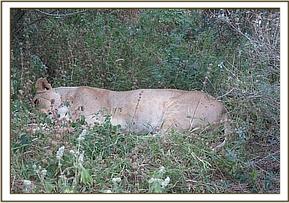

Reversal and Prognosis
Reversal was done seventy five minutes after darting. Fifteen milligrams Atipamezole was injected into her neck muscle. We pulled back some distance to wait for her to gain consciousness. She began with pulling her tongue back into her mouth at fifteen minutes post reversal. Palpebral reflex together with ear twitching were noted at the twenty fifth minute and she gained sternal recumbence at the thirtieth minute. She was on all fours after thirty fifth minute and made her way back into the thicket. We pulled away leaving Lion Guardians to do the rest of the night monitoring, repulsing her from the boma if needed. Her prognosis is good.
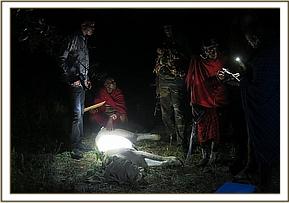

Acknowledgement
The Unit wishes to acknowledge the sponsorship of DSWT through KWS. Also recognized are the local community through community conservancies, non-governmental agents such as Big Life Foundation, the local KWS administrations and personnel who have been of great assistance to the work done during the month under review, and common bystanders for their continued support.
